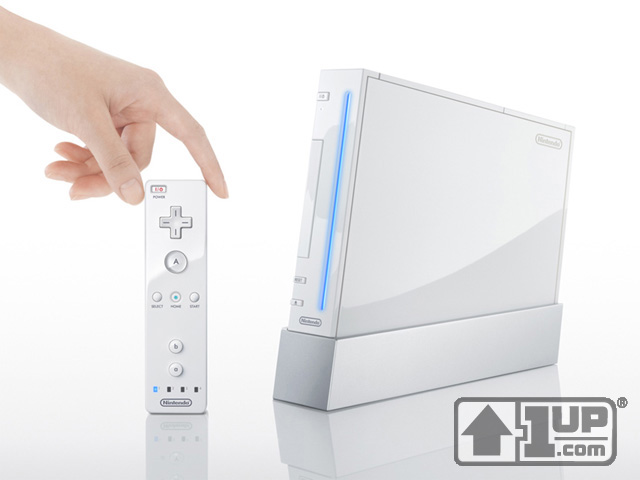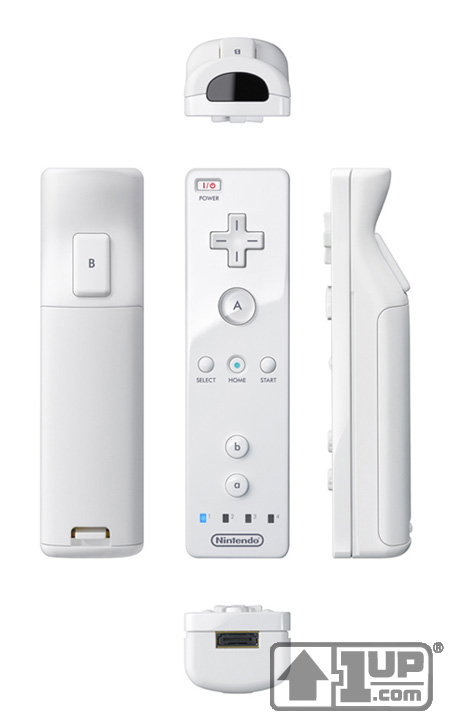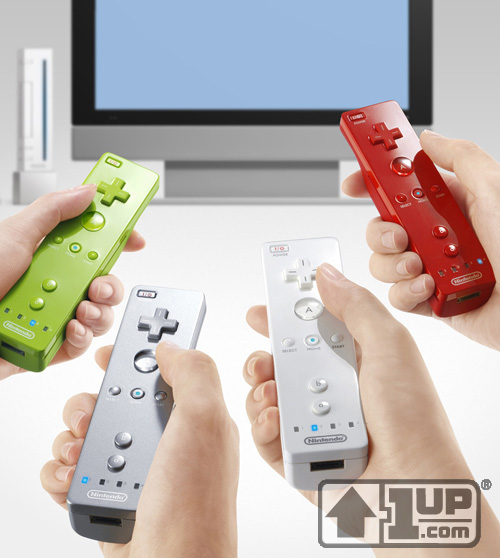Revolution controller :O

The Revolution Controller Basics: What The Hell Is It?
The controller for Nintendo's upcoming Revolution home console system is a cordless remote-control-like device designed to be used with only one hand. Two small sensors placed near the TV and a chip inside the controller track its position and orientation, allowing the player to manipulate the action on screen by physically moving the controller itself. For example, you could slash an in-game sword by actually swinging the controller from side to side, turn a race car just by twisting your wrist, or aim your gun in a shooter by pointing the controller where you want to fire.
An expansion port on the bottom of the unit allows for add-on hardware to compliment this "remote controller" (our word for it, not Nintendo's), like a second controller piece Nintendo demonstrated that comes equipped with an analog stick and two trigger buttons (currently labeled Z1 and Z2, for those of you keeping track). When the two controller pieces are attached, the so-called 'Nunchaku' configuration (the two bits are connected by a short cord) can work similarly to current controllers, just with the second analog stick replaced by actual movement of the Revolution controller. Nintendo also mentioned that the controller stick could be slipped inside other, more conventional controller shells, dance mats, bongos, or other peripherals.
A large "A" button sits in the prime spot under your thumb on the face of the controller, with a "B" trigger on the back of the unit for your index finger. Otherwise the button configuration is an interesting mix of old and new: standard D-pad up top, near the power button (to turn the Revolution console on and off), Start and Select in the middle, on either side of the intriguing "Home" button (Nintendo wouldn't go into detail, but sounds like it has to do with navigating system menus, which will be important given the Revolution's promised WiFi connectivity), and two more buttons near the bottom labeled "a" and "b." These last two may seem uncomfortably low for your thumb until you turn the controller 90 degrees and it becomes just like an old 8-bit NES joypad, with the D-pad under your left thumb and "a" and "b" under your right. (Don't forget-Nintendo has promised downloadable versions of their classic games for the Revolution's "Virtual Console.") Nintendo mentioned the button names and their exact sizes could still change slightly before production, but what you see here is close to the final design.
Elsewhere on the controller, the four lights at the very bottom represent which player it belongs to, and that hatch on the back is the battery compartment. (The prototype Revolution controllers we saw used regular batteries just like the GameCube's WaveBird wireless controller-and last a similar amount of time, according to Nintendo-but reps wouldn't say for certain if the final unit would use batteries or some rechargeable option.) The effective maximum range for the wireless controller is expected to be somewhere between 10 and 15 feet. A variety of different colored controllers were on display, including red, lime green, white, gray, black, and silver. Finally, rumble functionality is built in to the controller.

The Revolution Controller Demos: How It Works.
Alright, so enough about sticks and buttons and lights-how does this crazy new controller actually work with games? To answer that question, Nintendo's legendary game creator Shigeru Miyamoto (creator of Mario, Zelda, Donkey Kong, Pikmin, you name it) walked specially selected members of the press through a series of hands-on technology demos. These were not real Revolution games (all the names for the demos are ours)-they were super-simple, graphically crude offerings designed solely to show off different aspects of how the controller can work. Here's a rundown of what we saw, along with our thoughts on each:
A firing-range-like contest where two players compete to see who can shoot randomly appearing squares first. Aiming is done by pointing the controller itself at different points on screen, pulling the B trigger to fire.
IMPRESSIONS: A great demonstration of how intuitive the controller can be-pointing it to aim felt perfectly natural, right from the very first second, just like with a light gun. It always shot exactly where it felt like I was aiming, and was incredibly responsive to even slight wrist movements-I barely had to move my hand at all.
DEMO: GONE FISHIN'
Grab a pole and lower it into a 3D pond full of fish. Keep the line steady and when you feel a nibble from the rumble of the controller, pull it up quick!
IMPRESSIONS: An interesting showcase of the controller's 3D movement detection-you position the fishing pole above the pond by moving the controller forward or back, left or right in actual space, then lowered the hook by lowering the controller. It was a bit difficult to keep it steady in the water, but flipping the controller up when you got a bite, mimicking the motion of pulling up a fish in reel life, was a little thrill that just felt right.
DEMO: IRRITATING STICKS
Two players guide rotating sticks through a side-scrolling maze of tunnels and moving obstacles, gathering coins and avoiding touching the walls. (A lot like the PS1 game Irritating Stick, and exactly like the import-only GBA game Kuru Kuru Kururin.)
IMPRESSIONS: Another demo that needed no explanation, you just "got" it immediately-move the controller in whatever direction you want the stick to go. As a 2D game that requires exact movement (the caves get really narrow in parts), this one reinforced how precise and steady the controller's movement detection can be. Another interesting tidbit-if your controller fell outside the detection "box," the demo had an arrow pointing off the edge of the screen in that direction so you could get it back in the correct space.
DEMO: AIR HOCKEY
Exactly what it sounds like: Two players each control a flat stick on either side of a rink by moving around their controller, pushing a puck back and forth, trying to keep it out of the goal on their side.
IMPRESSIONS: A bit sloppy and more sluggish than the other demos, this one was supposed to show how you could put "english" on the puck by twisting the controller but in practice it didn't work as well as in other demos (and I'm not saying that just 'cause I kept scoring on my own goal...wait...OK, actually it is partially because of that.).
DEMO: BASKETBOWL
Two players drag or push a ball to their opponent's basket by making the ground under their controller-maneuvered cursor dip (by holding "B") or rise (by pressing "A").
IMPRESSIONS: This was oddly fun-you could try to move the ball by either making a hill next to it and pushing it along, or making an indentation for it to fall into, then using it to drag it across the court. When you got close to the basket, turning an indentation under the ball into a hill suddenly would fling it up into the air.
DEMO: WHERE'S WALDOASAUR
A simple demonstration of depth perception-the player searches for a particular pokemon on a giant map filled with the creatures (ala Where's Waldo), zooming in by pushing the controller towards the screen and zooming out by pulling away from it.
IMPRESSIONS: Nothing much to say here except that, as a Nintendo rep commented, you can see how this might be put to use for aiming a sniper rifle in a first-person shooter.
DEMO: PILOT WANGS
Manipulate a biplane through the air, trying to fly through rings scattered around the Isle Delfino hub world of Super Mario Sunshine.
IMPRESSIONS: This was about all the different ways the Revolution can detect tilting the controller. It was as if the controller was the airplane itself - as long as your movements weren't too sudden, the on-screen action would mimic your movements with very little lag time. After about a minute I was pulling dramatic dives and loop-de-loops, bullseye-ing plenty of rings.
DEMO: METROID PRIME-TIME
Nintendo saved the best for last. This was the first section of the GameCube game Metroid Prime 2: Echoes, retrofitted to be compatible with the Revolution controller and its analog add-on piece (the "Nunchaku" set-up mentioned earlier). As on the Cube the analog stick controls movement, but instead of holding down a button to look around, you simply point the other controller in the direction you want to aim.
IMPRESSIONS: At first, I was standing up and swinging my hand all around to aim - and my arms got really tired really quick. But once I sat down and relaxed, resting my hands on my legs as I would with a normal controller, everything clicked. It wasn't perfect yet - the Revolution controller functionality had just been added recently and wasn't bug tested or polished, so every so often the view would "spaz out" for a couple seconds - but it was enough to get me excited. As odd as it may look holding the two separate controller pieces, one in each hand, looking around felt incredibly natural, even more than my preferred PC-style keyboard-and-mouse setup. I have to wonder about precision and speed in multiplayer games, but for a more deliberate single-player game like Metroid Prime - and the series is already confirmed for an appearance on the Revolution - this setup already has huge potential.

The Revolution Controller Design Philosophy
So why has Nintendo decided to brazenly break with tradition and the conventions of every other modern console in creating the Revolution controller? According to Mr. Miyamoto, it was part of a conscious decision to make something simple and straightforward enough to reach out to a new audience. "We want a system that takes advantage of new technology for something that anyone, regardless of age or gender, can pick up and play. [Something with a] gameplay style that people who have never played games can pick up and not be intimidated by. We wanted a controller that somebody's mother will look at and not be afraid of."
Of course, Nintendo has no intention of leaving their traditional audience behind, and Mr. Miyamoto is quick to add that the controller is already well suited for a number of popular genres. "[We aimed for something] that is simple enough for everyone," he says, "but also something that people who've been playing games for years will be satisfied with."




0 Comments:
Publicar un comentario
<< Home